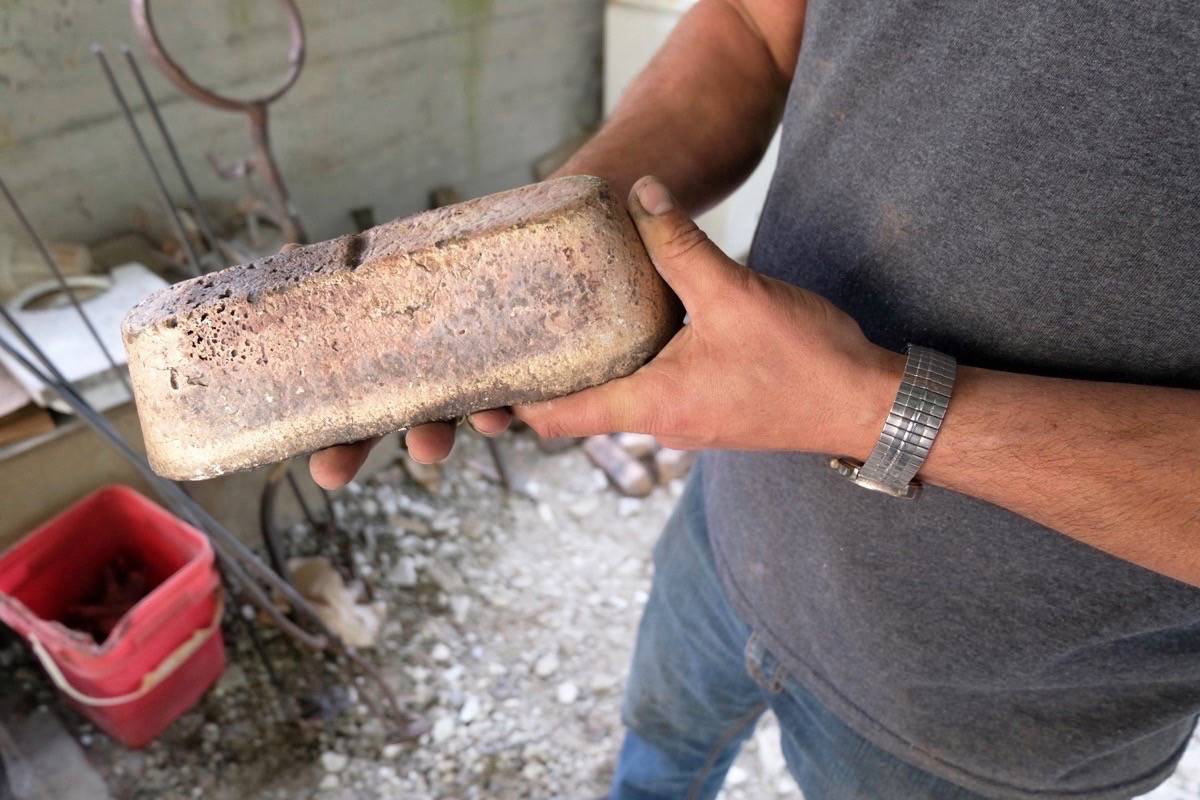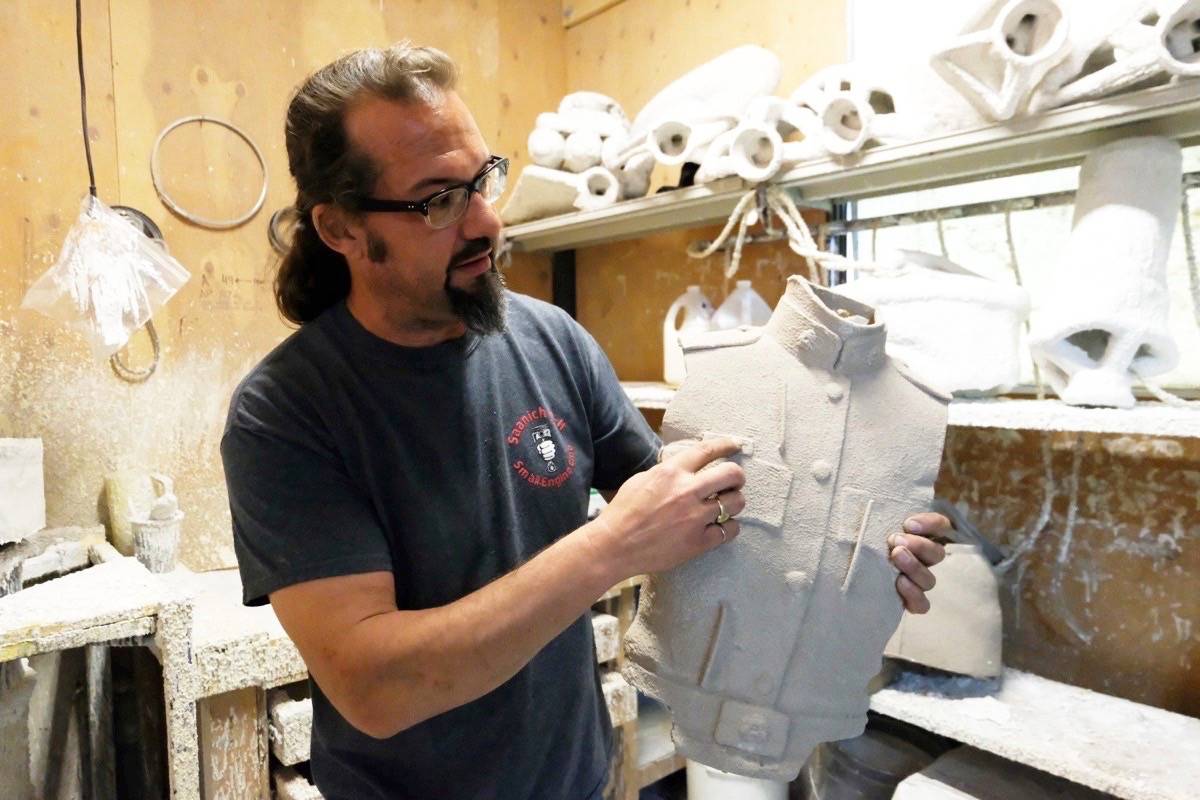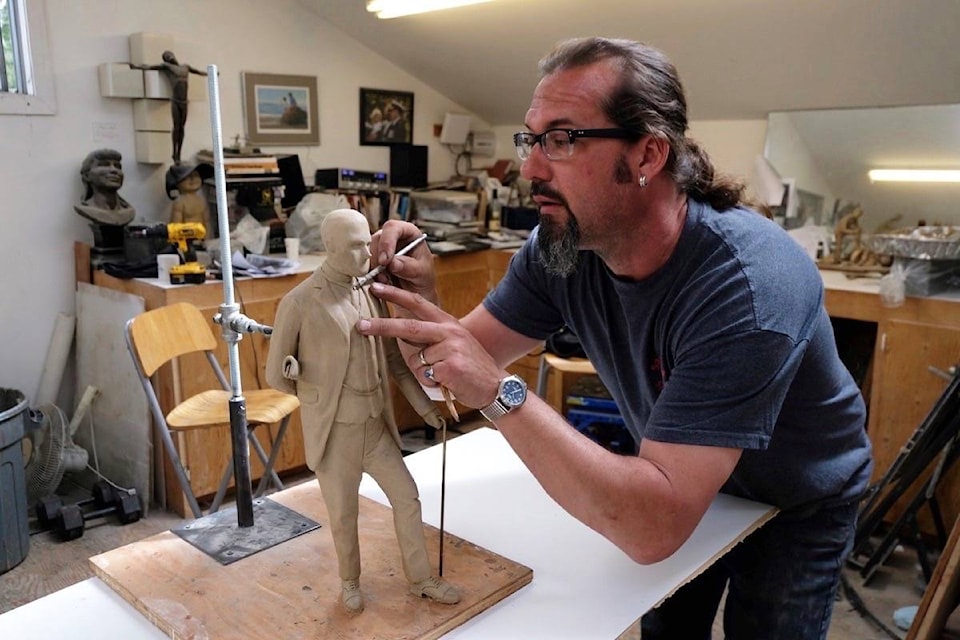Alisa Howlett/News staff
A local artist is paying tribute to prime ministers of the past, while also leaving behind a legacy of his own.
Nathan Scott, a bronze sculptor in Brentwood Bay, is one of six artists across Canada who has been commissioned to make life-size sculptures for the prime minister statue project that will be installed on the grounds around Castle Kilbride in Baden, Ont. The privately-funded statue project, created to mark Canada’s sesquicentennial, will feature bronze replicas of Canada’s 22 past prime ministers.
“Bronze will last for 10,000 years, so there’s my legacy, eh?” Scott says to the PNR, in the upper part of his workshop that’s crammed with clay statues, some of them still headless and unfinished.
Bio
Scott has been sculpting for nearly 20 years and is one of the few bronze sculptors in the country with his own foundry. He has around 30 public commissions across Canada now. Some of his most well-known are: Terry Fox at Mile 0 in Victoria; The Homecoming, a bronze figure sculpture commemorating the 100th anniversary for the Canadian Navy in downtown Victoria; and The Bench People, bronze-finished sculptures sitting on benches scattered throughout Sidney.
Prior to sculpting, right after high school graduation, Scott worked as a gold miner in the Yukon for 10 years. Tired of the “wicked,” camp lifestyle he returned to the Island and began painting murals with a friend.
“I’m colour blind and two dimensional just doesn’t work. I’m better than I think, but I just didn’t enjoy it,” he says.
It wasn’t until he got an odd job creating a mascot for a Victoria carpet cleaning company that he truly realized his talent.
“It came so naturally, really. It’s such a gift. It really is. This whole thing,” Scott says. “And I thought ‘Wow, I really must be onto something.’”
Going with this momentum, Scott had the idea to sculpt something for Victoria, also known as the City of Gardens, that he hadn’t seen before.
“I didn’t want to do any cherubs or gargoyles, they had already been done; but I had never seen any four-and-a-half-foot gardeners.”
Encouraged, or “forced” as Scott jokingly puts it, by a friend to enter his work in a Vancouver Island Sculptures Guild show, Scott sold nine of his little gardeners at $5,900 each.
Six months later Scott received his first public commission, The Bench People.
Borden statue
Scott has just started the sculpting process of Canada’s eighth prime minister Sir Robert Borden. Borden served for two terms (1911 to 1920), right in the midst of World War I.
“I’m thrilled. You know, the more I sculpt … the more things I do that are historical and the more I learn,” says Scott. “(Borden) didn’t even want to be the prime minister, he was just in a spot where he said, ‘Crap – here I go.’ Then suddenly there was war; who was going to know about that? … How normal people get thrown into situations and they have to deal with it, it’s very exciting.”
Scott plans to incorporate some – about 25 – historical clues about Borden’s life inconspicuously in the sculpture. This is known as “Easter eggs.”
“This is an educational aspect. So a sculpture is a sculpture, but if you can add more to it, like details, it helps,” Scott says. “They’ve given me a list of all these symbols or emblems or different things he’s famous for – the Treat of Versailles, World War I, Daylight Savings, his birthplace, where he died – so you know, all these different things of history about him. I have to be able to put those somewhere within the sculpture itself.”
To accomplish this, Scott’s plan is to sculpt props for Borden where he can inscribe the details. The statue of Borden will have a newspaper tucked underneath his arm and will be holding a cane in one hand and a hat behind his back in the other.
“People don’t want to sit there and be reading these things in weird places, like on his body or his clothes. You have to do it in such a way it doesn’t take away from the sculpture.”
The process
The process is detail-oriented and lengthy. From start to finish, the six-foot, one-inch 500-pound sculpture of Borden will take Scott around six months to complete, with two months of that strictly for sculpting. Here is his process in a nutshell.
Scott starts out any project by photographing the subject he intends to sculpt. For the prime minister statue project, Scott plans to dress up a local, distant relative of Borden’s in the clothes his sculpture will have. This way he can get precise measurements and photos for the piece.
“It’s about realism, it’s not about what’s in my head,” Scott says.
From these photos and measurements he carves a positive sculpture out of a non-drying clay. The next step is to create a negative mold over that, usually made from Polyurethane and fibre glass, to capture all the details and undercuts. A mother mold is created to cover the fibreglass to help keep its shape. He then recasts a positive wax out of the negative mold. The wax casting is what will depict the thickness of the bronze.
A life-size sculpture of a person is usually cut up into about 14 pieces, then dipped in ceramic. Once the ceramic is hardened the wax gets burned out in a furnace at 1800 degrees. The heat permeates the ceramic mold and the wax comes out, leaving a negative shell that the bronze is poured into.
The bronze pieces are then welded together and left for finishing work, which includes sandblasting, chasing and patinas.
The project
Sir John A. MacDonald is the only statue so far completed. The statue, by Ruth Abernethy of Ontario, was unveiled in 2015. The other commissioned artists include: Darren Byers and Fred Harrison of New Brunswick, Alan Henderson of Alberta and Morgan Macdonald of Newfoundland.
The second and third prime ministers will be unveiled right before Canada Day on June 29. Scott’s statue of Borden will fittingly be unveiled by Remembrance Day.
Funds still need to be raised to commission the rest of the prime minister statues, but Scott says he hopes he proves himself with Borden because he would like to sculpt Wilfrid Laurier or Pierre Trudeau next.


